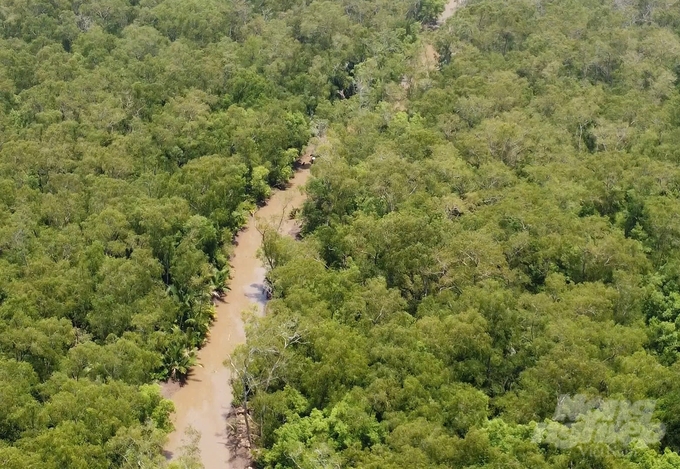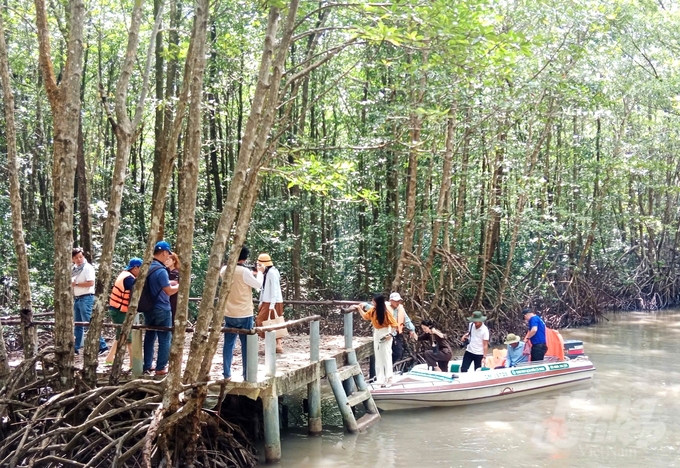June 19, 2025 | 06:51 GMT +7
June 19, 2025 | 06:51 GMT +7
Hotline: 0913.378.918
June 19, 2025 | 06:51 GMT +7
Hotline: 0913.378.918
U Minh Ha National Park (Ca Mau province) was recognized by UNESCO in 2009 as one of the three core areas of the Ca Mau Cape World Biosphere Reserve.
This is a typical melaleuca forest ecosystem on peatland in the Mekong Delta region, serving as a model for melaleuca forest restoration in wetlands. Besides, U Minh Ha National Park also holds significant cultural and historical values preserved over various periods.

U Minh Ha National Park is one of the most notable conservation areas for Melaleuca forests on peatland in the Mekong Delta, with very high biodiversity. Photo: Trung Chanh.
According to Mr. Le Thanh Dung, Deputy Director of U Minh Ha National Park, the park covers a total area of nearly 8.528 hectares, of which more than 1,700 hectares are natural forests. The park is divided into three functional zones: a strictly protected area, an ecological restoration area, and an administrative service area.
U Minh Ha National Park is highly diverse, with 176 species of plants, 23 species of mammals, 91 species of birds, 37 species of fish, and 47 species of amphibians and reptiles. Several species listed in the Vietnam and global Red List can be found here, such as the Java pangolin, fishing cat, smooth-coated otter, long-tailed macaque, king cobra, lesser adjutant, and Malayan night heron. Additionally, some economically valuable freshwater fish species inhabit the park.
Conserving the biodiversity of U Minh Ha National Park means protecting the unique melaleuca forest ecosystem on peatland in the Mekong Delta, with a focus on preserving cultural and historical values, while restoring and maintaining vegetative cover. However, conservation does not mean “closing the door” but rather the current approach is “conserving for development and developing for better conservation”.
To contribute to forest protection and development, especially enhancing the economic value of the forest, the People's Committee of Ca Mau province has approved the ecotourism development Plan for U Minh Ha National Park. This plan aims to develop ecotourism while conserving and developing the melaleuca forest ecosystem, preserving landscapes, and protecting the environment.
The focus is on developing tourism products such as a wildlife and medicinal plant garden, the melaleuca forest ecosystem, forest village models, cuisine, and relaxation activities. There are also efforts to connect the park with other tourism sites within and outside the province, such as Hon Da Bac and Trem river ecotourism, as well as community tourism households.

Developing ecotourism in U Minh Ha National Park will create economic potential for forest protection and development while connecting with other tourism routes within the province, thereby promoting socio-economic development. Photo: Trung Chanh.
According to Mr. Le Thanh Dung, the park is gradually implementing the contents of the ecotourism development plan through 2030. The park follows the principle of developing tourism for conservation, ensuring that tourism activities do not affect the forest ecosystem. Additionally, the park implements a benefit-sharing mechanism with the buffer zone communities to collectively protect the unique Melaleuca forest ecosystem of U Minh Ha. Ensuring income and stable livelihoods for local residents is one of the key aspects of forest protection and biodiversity conservation.
Additionally, the park implements a benefit-sharing mechanism with the buffer zone communities to collectively protect the unique melaleuca forest ecosystem of U Minh Ha. Ensuring income and stable livelihoods for local residents is one of the key aspects of forest protection and biodiversity conservation.

U Minh Ha National Park, as one of the three core areas of the Ca Mau Cape World Biosphere Reserve, has great potential for ecotourism development, attracting tourists for sightseeing, experiencing, and scientific research. Photo: Trung Chanh.
The Park will strengthen its links with local communities to diversify tourism products, building offerings that reflect the cultural identity of each local community. The park is also calling for organizations, individuals, and domestic and international projects to support technical infrastructure for local community tourism. Along with this, efforts will be made to promote tourism and establish local livelihood models in buffer zone communities.
Moreover, based on the benefit-sharing mechanism, U Minh Ha National Park will seek support from various organizations and individuals through community livelihood development projects, aimed at improving the lives of buffer zone residents. This is also a way to raise awareness and responsibility within the community for better conservation and sustainable development of the forest ecosystem in U Minh Ha National Park in the future.
The initiative to lease forest environments for tourism development, particularly ecotourism, scientific research, and forest resource conservation combined with under-forest economic activities, is considered an effective solution for forest protection and development.
Translated by Kieu Chi
![Turning wind and rain into action: [9] Digitizing hydrometeorological data in response to climate change](https://t.ex-cdn.com/nongnghiepmoitruong.vn/608w/files/news/2025/06/17/z6704423696987_15fd32ffc26d590d204d520c9dac6786-nongnghiep-165943.jpg)
(VAN) Farmers have begun accessing hydrometeorological applications to adjust their cropping schedules, aiming to ensure productivity and adapt to climate change.
![Turning wind and rain into action: [8] Real-time salinity detection and early warning technology](https://t.ex-cdn.com/nongnghiepmoitruong.vn/608w/files/news/2025/06/17/z6704423696987_15fd32ffc26d590d204d520c9dac6786-nongnghiep-151127.jpg)
(VAN) Thanks to the integration of modern hydrological-hydraulic models, remote sensing technologies, and artificial intelligence, the accuracy of hydrological forecasting has significantly improved.
![Turning wind and rain into action: [7] Early disaster warnings help marine farmers minimize losses](https://t.ex-cdn.com/nongnghiepmoitruong.vn/608w/files/news/2025/06/17/z6704423696987_15fd32ffc26d590d204d520c9dac6786-nongnghiep-142942.jpg)
(VAN) In recent years, thanks to early disaster warnings and forecasting, marine farmers in Khanh Hoa province have been able to reduce risks and losses, thereby improving production efficiency.
![Turning wind and rain into action: [6] ‘Four on-the-spot’ disaster management software](https://t.ex-cdn.com/nongnghiepmoitruong.vn/608w/files/news/2025/06/17/e5a48259d6a262fc3bb3-nongnghiep-183800.jpg)
(VAN) By simply activating the scenario on the disaster management software, the relevant authorities immediately know how many households need to be evacuated, where to evacuate them to, and by what means of transportation…
![Turning wind and rain into action: [5] Hue applies modern technology in disaster forecasting](https://t.ex-cdn.com/nongnghiepmoitruong.vn/608w/files/news/2025/06/17/z6704423696987_15fd32ffc26d590d204d520c9dac6786-nongnghiep-093938.jpg)
(VAN) In Hue city, modern technology has recently been applied in meteorological and hydrological forecasting and warning, helping to reduce the damage caused by natural disasters.

(VAN) A cutting-edge farming technique being implemented on an experimental ranch in Arizona's Sonoran Desert has already saved a billion gallons of water over five years, according to Civil Eats.

(VAN) Poultry and pig production and the environment can be boosted through enhanced water technology, according to new research.